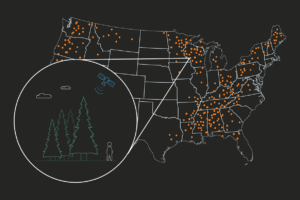On June 17, NCX submitted comments in support of the U.S. Securities and Exchange Commission’s (SEC) proposed climate risk disclosure rules. The proposed rules require publicly traded U.S. companies to report to investors the ways that they assess and manage climate-related financial risk, including information on net-zero strategies and any use of carbon offsets.
At NCX, we believe there is a need for increased transparency and integrity in the quickly growing voluntary carbon market. We strongly support the SEC’s efforts to increase disclosure of relevant climate-related information available to investors. In our comments to the SEC, we supported the disclosure of information about companies’ emissions as well as their climate-related goals and strategies. We also proposed several modifications and additions of information specific to carbon credits that are, in our view, key to identifying high-impact offsets and thus ensuring the integrity of corporate climate progress.
NCX submitted two sets of comments to the SEC. The first was a letter led by the Clean Air Task Force and co-signed by NCX, Clean Air Council, Clean Wisconsin, Partnership for Policy Integrity, and National Wildlife Federation. This letter gives a comprehensive view of the climate-related information that we believe companies should be required to disclose under the SEC’s proposed rules. We recommended the disclosure of relevant information regarding companies’ GHG emissions; climate targets and transition plans; and use of carbon offsets. Without this information, investors will not be able to assess the climate-related risks and benefits relevant to corporate business strategy.
The second was an independent letter that focused on the use of carbon offsets. We are particularly interested in making sure investors have information about the risk associated with certain types of carbon credits, and that they can assess the actual delivered impacts of carbon offsets. As a result, in addition to specific identification information for all purchased credits (such as the developer, project, methodology, and vintage year), we recommend disclosure of details related to two central issues: additionality and risk of non-delivery. This information is not currently available, which creates a significant barrier to understanding the real impact of the voluntary carbon market.
Additionality means that a carbon project has to create carbon sequestration above what would have happened otherwise (rather than just paying for carbon storage that would have happened anyway). A carbon offset only represents a real climate benefit if it is shown to be additional. We recommended disclosure of 1) how purchased offsets assessed additionality, and 2) whether additionality was actually measured, or whether it was simply presumed to exist over the life of the offsets (e.g. carbon storage delivered over decades).
Risk of non-delivery is higher when carbon credit programs issue credits ex-ante (paying up front for promises of future carbon storage) than when they are issued ex-post (paying and generating credits only after the carbon storage is fully delivered). Unfortunately, when credits are issued ex-ante, they are exposed to the risk of disruptions like wildfires and disease, which can wipe out the original credits’ claimed climate benefits. Buffer pools are currently used to mitigate risk in ex-ante projects but recent studies have put their reliability in question. To assess this risk, we recommend that the SEC require companies to disclose the following information about their purchased offsets:
- Whether the credits were issued ex-ante or ex-post.
- The number of years before the impact of the credits are fully delivered.
- The rate at which the climate benefit was delivered over that period.
- The methods used to evaluate risk of reversal or non-delivery, and the use of governance measures like buffer pools.
We believe that investors should be able to access standardized and accurate information related to corporation’s climate impacts and their progress towards stated climate goals. Currently, this information is not available, especially when it comes to carbon offsets. Investors do not have the necessary tools to evaluate the real impacts of corporate offsetting and the quality of the underlying carbon credits. Done correctly, the SEC’s proposed rule could help deliver the transparency that carbon markets desperately need, raise the bar for offset quality, and support the U.S. climate response overall.
To read the full comments, please see the linked pages below.
CATF Comments on the SEC’s Proposed Climate Risk Disclosure Rules
NCX’s comments on SEC’s Proposed Climate Risk Disclosure Rules



